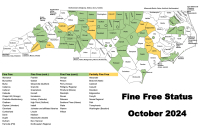Geologists nearly finished with Macon landslide study
By Sarah Kucharski • Staff Writer
N.C. Geological Survey staff hopes to finish its survey of Macon County’s landslide prone areas by the end of this month and present its research to county commissioners.
The survey is part of a landslide risk analysis of Western North Carolina undertaken after the region suffered multiple slides triggered by heavy rains from Hurricanes Ivan and Frances in 2004.
“There’s no program in the country that is doing this at the scale and the pace at which we’re doing this,” said geologist and engineer Rebecca Latham, who presented some of the survey’s findings to member of the Macon County League of Women Voters Thursday, June 8.
Macon County was selected to be the first to receive landslide analysis largely due to the tragic slide that killed five people and destroyed 16 homes in the Peaks Creek community.
The slide at Peaks Creek began as a slab of dirt, boulders and trees about the size of a football field broke loose from the top of Fishhawk Mountain. Picking up speed and debris along the way, the slab plowed down the creek bed for more than two miles, destroying everything in its path.
Related Items
The slide is what geologists call a debris flow, which typically begins on a slope 30 degrees or greater, where soil comes in sharp contact with bedrock — picture the lay of the land in a V-shape. Here water, both from precipitation and underground flows, tends to converge and dislodge the soil from below.
As the soil breaks loose, gravity pulls it down the same path that water would flow. Most often this path is along a stream. In the case of Peaks Creek those who had built their homes closest to the stream suffered the most damage, while those just a few feet farther back were unscathed.
But while Peaks Creek received much media attention, locally and nationally, such slides are not altogether uncommon in the mountains, Latham said.
“A hurricane isn’t the only thing that can produce landslides,” she said.
According to N.C. Geology Survey findings, five inches of rain or more within a 24-hour period typically is what it takes to start landslides.
One advantage in attempting to predict where landslides will occur is that history tends to repeat itself.
“Where they happen once they typically will happen again,” Latham said.
In mapping the area, geologists have found evidence of old landslides such as in Maggie Valley where the mountain gives way to a valley of rental housing units. The units are built on the residue of an old debris flow, Latham said. Such places, called debris fans, are great to build on as they are relatively flat, and there’s often easy access to water. The fans are not unsafe places in and of themselves. The question is — what is being built above?
“It is possible to build in the mountains, but it is important to know where you’re building and what you’re building on,” Latham said.
Homeowners and those looking to build should examine their property for bent trees, those that have curved trunks at the bottom.
“If you see a whole slope of trees like this I would start scratching my head a little bit,” Latham said.
Foundations that are popping or cracking, and unusual breaks in the land that look like one piece has broken away from another also are indicative of land that is on the move.
Exactly what will come of the N.C. Geological Survey’s mapping efforts is unknown. The organization has no regulatory power and thereby cannot force local lawmakers to acknowledge its findings.
“If they want to throw them in a drawer and never look at them, we can’t stop them from doing that,” Latham said.
However, staff members are beginning to have conversations with Realtors’ groups, educating them about how landslide prone areas play into the full disclosure clause. If a Realtor knew that a home was subject to landslide activity, he or she could be held responsible if one occurred, Latham said.
For more information about the mapping project visit www.geology.enr.state.nc.us. GIS maps of Haywood and Macon counties also are available at www.nconemap.com. Such maps include topography, flood plain and soil information.









